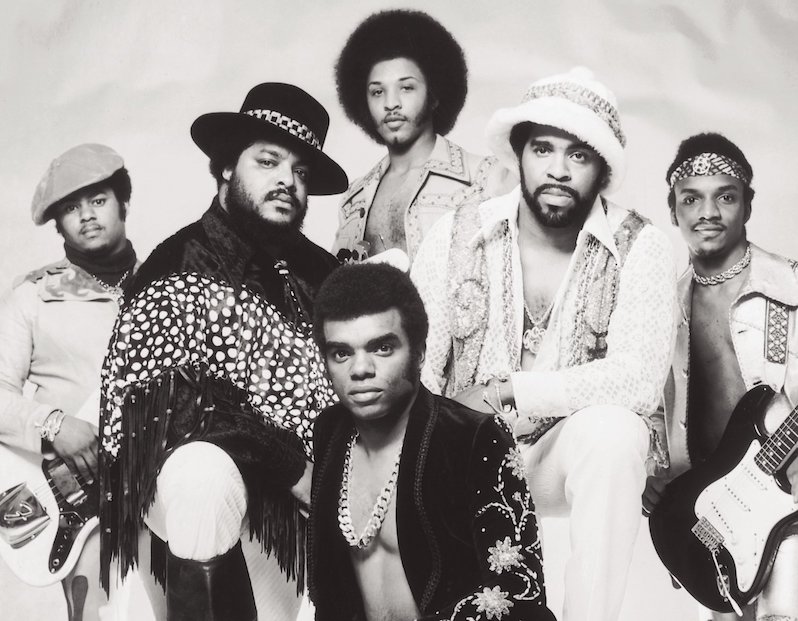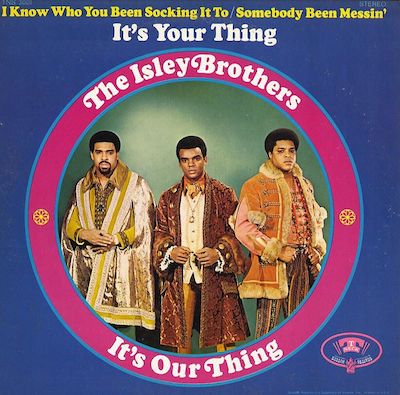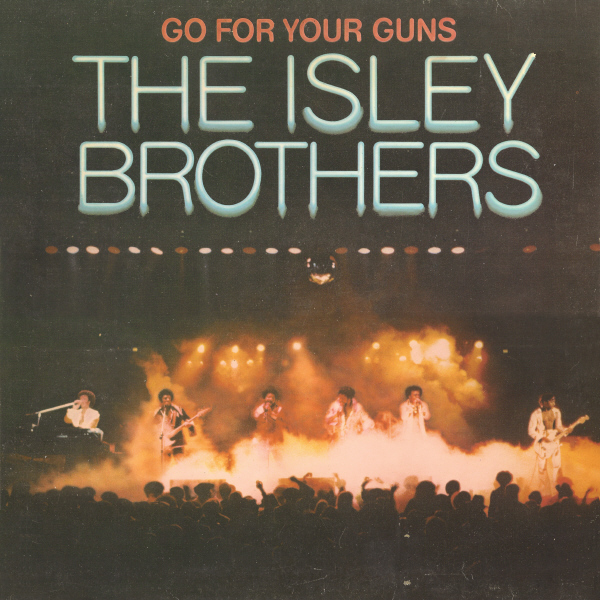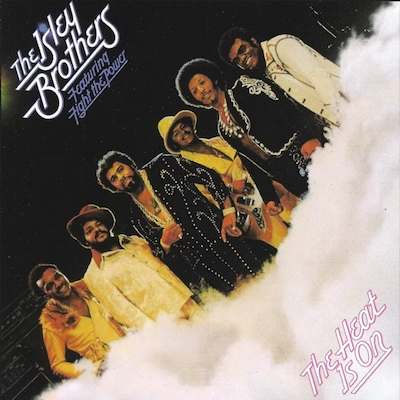A Beginner’s Guide to the funk-soul of The Isley Brothers

To understand the limitations of canons, look to The Isley Brothers. The Cincinnati, Ohio group—founded by brothers O’Kelly, Rudolph and Ronald Isley—is one of the most prolific funk-soul groups of all time, releasing more than 30 studio albums, nine of which went platinum, another four of them going gold, and perhaps most incredible of all, their best selling albums mostly coincide with what are in fact their best albums. And considering how big the divide is between critical acclaim and commercial success, sometimes, that’s a rare thing indeed.
But for a group as enduring and as successful as the Isleys, they’re often left out of the conversation in terms of the greatest albums of all time, or even just the decade in which they were released. Acclaimed Music, for instance, only lists one album of theirs—1973’s 3+3—which has appeared on publications’ best-albums lists (which includes the Rolling Stone 500, as our writer Virginia Croft recently took a trip through, but by and large mostly comprises British publications). It’s a little hard to square the decades-long evolution and artistic reinvention of The Isley Brothers did, while maintaining an increasingly massive audience for much of that time, with what seems like widespread critical amnesia.
Perhaps it’s generational, though the group did enjoy a revival in the ’90s due to widespread sampling from hip-hop artists, a commercial rebound with 1996’s Mission to Please, and, regrettably, several collaborations with R. Kelly. But that took place four decades(!) after the group’s career began. Much like Parliament-Funkadelic, The Isley Brothers’ roots are in doo wop and gospel, and from there they spiraled outward, embracing funk, rock and psychedelia, and eventually finding their way to synth- and drum-machine-enhanced ’80s boudoir jams.
There’s a lot to hear in the Isleys’ catalog, much of it familiar, some of it vastly underrated, but all of it worthy of rediscovery. It might not rewrite the canon, but I hope this Isley Brothers guide, featuring five of their best albums to start with, at least puts them in a few new fans’ regular rotation.

It’s Our Thing
The real place to start with The Isley Brothers is where they started, essentially—1959’s “Shout.” Their seventh single and first to chart achieved a ubiquity well after its release. You know “Shout,” you’ve danced to “Shout” at weddings. You might not have even known it was The Isley Brothers, but you’ve definitely experienced it. So I don’t feel the need to put too much attention on that song, instead offering 1969’s It’s Our Thing as a perfect entrypoint to the band of brothers’ versatile and constantly evolving funk-soul sound. This one’s not nearly as ubiquitious as that crowd-pleasing party anthem, but it does feature “It’s Your Thing,” a badass strut of a late ’60s funk track that’s probably in the group’s five best-known tracks (their Spotify top songs supports my hypothesis; TIDAL’s top tracks lean more toward the psych-soul and slow jams). But the Isleys’ sixth album, released more than a decade into their career, is the beginning of what became an unstoppable era of great records for the group. And it starts with a lot of sweaty James Brown groove, Otis Redding-like deep soul anguish, and heavy concerns about who’s socking it to whom. Highlights like “Somebody Been Messin'” and “It’s Your Thing” are satisfying upon impact, grooves that hit efficiently and without delay. But it’s in the slower, more psychedelic numbers like “Feel Like the World” where the Isleys showcase more depth and subtlety, balancing a hazy melancholy with a gospel backing that shows more or less where Spiritualized got their best tricks (which they do justice to, but certainly didn’t invent). The Isleys’ gospel and doo wop roots were the foundation, but what they began to build upon that here is spectacular.
Stream: Tidal

3+3
The Isley Brothers’ first 15 years are an ever-more-steeply sloping upward curve, their early singles great ’50s R&B tracks, big on hooks and soul, and everything thereafter simply adding another element to make it that much better. By the time they released 3+3, they had deepened their groove, embraced psychedelia, and had grown immensely as songwriters as well. But adding younger brother Ernie Isley as guitarist on 1973’s 3+3 provided the x-factor that made the album a showstopper. On “That Lady,” another Isleys hit that’s stood the test of time (and appeared in more than a few TV commercials), Ernie’s guitars are the focal point, squealing and psychedelic, melodic but defying gravity. Though the band had dabbled in psychedelia before, this was their definitive psych-soul moment, an absolute jaw-dropper of a first cut. Not all of it is so wildly flashy, which is a good thing; soulful struts like “If You Were There” and “You Walk Your Way” are a warm come-down from that early high, while their covers of “Listen to the Music” and “Summer Breeze” show what kind of magic they can pull out of other people’s songs. And pretty much the entirety of Side B maintains a persistent Sly Stone-like funk momentum that makes it an absolute joy to play from front to back. But more than anything, it’s about that guitar—play on, Ernie.
Stream: Tidal

Go For Your Guns
Twenty years after releasing their debut single, The Isley Brothers made their greatest album. To hear both sides of Go For Your Guns is to hear a band on fire, every groove that much deeper, every riff that much hotter, and every rhythm played with maximal impact. It speaks volumes that in an era of just incredible funk bands, there’s still arguably few that can touch the Isleys on a purely musical level—there’s a reason why it was our Isleys pick for the Best Albums of the ’70s (though in hindsight choosing just one feels wrong, somehow). From the fluid clavinet and bass funk of “The Pride (Part 1 & 2)” that opens the album, Go For Your Guns finds the Isleys off to the races and showing no interest in slackening their pace. Four tracks here are titled in two parts, because essentially the group had the foresight to write songs easy enough to splice into radio edits while giving themselves the runway space to just ride out the funk. The most recognizable track here is “Footsteps in the Dark,” sampled in songs by both Ice Cube (“It Was a Good Day”) and Thundercat (“Them Changes”), though in its original form, it’s one of the band’s strongest, psychedelic, melancholy and curiously dark without slipping out of the pocket. Though “Climbin’ Up the Ladder” is that something extra to prove Funkadelic’s rhetorical maxim from 1978: A funk band most certainly can play rock, and best most of them in the process.
Stream: Tidal

The Heat Is On
It’s all right there in the title—the Isley Brothers just cook throughout the 37 minutes of The Heat Is On, delivering their most rubbery funk, big on hooks and deeply rhythmic. It’s perhaps less of an artistic breakthrough than 3+3 might have felt like at the time, but makes up for that by simply being a front-to-back astonishing set of songs. It’s one of the prime examples of the band’s penchant for dividing an album in two, the first half all their funk rave ups, the second half all their slow jams. There are moments in their catalog where they pretty much deliver nothing but funk, and who am I to find fault with that? (I can’t, I won’t.) Here there’s an interesting balance between the two, though it’s still Side A where the brightest gems are to be found, specifically “Fight the Power” and “Hope You Feel Better Love.”
Stream: Tidal

Between the Sheets
The Isley Brothers’ 22nd album, Between the Sheets, begins much in the same way that It’s Our Thing does: With Ronald Isley growing suspicious about infidelities. But that’s about where the similarities between the two end, other than, of course, the group’s outstanding musicianship and vocal performances. Between the Sheets is, true to its title, one of the greatest soundtracks for adults-only situations of our time. The Isley Brothers might not have invented the slow jam, but they essentially perfected it, and this album sets the template for R&B crooners to follow even decades later, with tracks like “Choosey Lover” and “I Need Your Body” awash in twinkly keyboard textures and buffeted by stark drum-machine beats. When Ronald sings, “Let’s make love between the sheets” in the title track, he’s pretty much telling you everything you need to know about this record, though even before that you’ll likely be caught by how recognizable its hook is—sampled by Notorious B.I.G. in “Big Poppa” (and its gloriously hypnotic coda, one of the greatest moments in their body of work as a whole, sampled by Jay-Z in “Ignorant Shit”). There are a few diversions from this approach, like the sociopolitical funk of “Ballad of the Fallen Soldier,” the fatback bass groove of “Slow Down Children” and synth-funk banger “Gettin’ Over.” Much like The Heat Is On, the album is split into two distinct sides; Side B rather than Side A is where the boogie begins, which makes this an outlier in a sense. I should also note that this isn’t necessarily one of the five best Isley Brothers albums (but probably top 10, there’s room for argument). It is, however, an essential part of the story, and still sexy as hell.
Stream: Tidal
Next Steps: To get a feel for just how alive and electric the group is, go back their 1973 live album The Isleys Live, comprising songs from before their 3+3 album, many of them covers. It kicks off with a spectacular rendition of “Work to Do” before easing into what’s mostly a set of tracks originally captured in the studio on Givin’ it Back, though these takes are far more thrilling, like their glorious, epic Young/Hendrix medley “Ohio/Machine Gun,” or the soulful and sensual reimagining of Dylan’s “Lay Lady Lay.” Following that, dive into the warm and rich Brother, Brother, Brother, an album that’s a little more organic and relaxed than their fiery mid-to-late ’70s material, but which best showcases the Isleys’ versatility and fluidity as a band.
Advanced Listening: There’s so much to hear in the Isley Brothers catalog that you can keep going for as long as the groove sustains you, though the mid-’70s is a particularly fertile era for them, so make sure to check out Live It Up, Harvest for the World and Showdown, then work backwards into the ’60s and forward into the ’80s. From 1985 on, it grows a little more inconsistent in part due to the splintering of the group, but even so, a three-decade run of mostly uninterrupted greatness is pretty hard to top.
Support our Site—Subscribe to Our Patreon: Become one of our monthly patrons and help support an independent media resource while gaining access to exclusive content, shirts, playlists, mixtapes and more.
Jeff Terich is the founder and editor of Treble. He's been writing about music for 20 years and has been published at American Songwriter, Bandcamp Daily, Reverb, Spin, Stereogum, uDiscoverMusic, VinylMePlease and some others that he's forgetting right now. He's still not tired of it.
